The Sand Testing Equipments Market is estimated to be valued at USD 470.3 million in 2025 and is projected to reach USD 730.3 million by 2035, registering a compound annual growth rate (CAGR) of 4.5% over the forecast period.
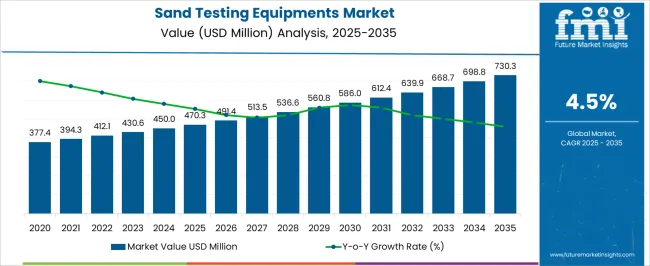
| Metric | Value |
|---|---|
| Sand Testing Equipments Market Estimated Value in (2025 E) | USD 470.3 million |
| Sand Testing Equipments Market Forecast Value in (2035 F) | USD 730.3 million |
| Forecast CAGR (2025 to 2035) | 4.5% |
The Sand Testing Equipments market is experiencing steady growth driven by increasing demand for quality control and performance assurance in construction and industrial applications. The market is being shaped by the rising need to ensure the durability and purity of sand used in construction, foundry, and industrial processes. Investments in infrastructure projects, growing urbanization, and stricter regulatory standards for material quality are fueling the adoption of sand testing equipment.
Technological advancements in automated testing, improved accuracy of results, and integration with data management systems have further accelerated market growth. The adoption of sophisticated instruments that can deliver rapid and reliable analysis of sand properties is increasing the efficiency of testing processes and reducing the risk of material-related failures.
As industries prioritize operational safety and product quality, the demand for sand testing solutions is expected to expand Future opportunities are anticipated in the development of multi-functional testing equipment and software-enabled instruments that enhance testing precision and offer better reporting and traceability capabilities across industrial and construction applications.
The sand testing equipments market is segmented by test type, offering, equipment type, and geographic regions. By test type, sand testing equipments market is divided into Organic Impurities Tests, Silt Content Tests, Particle Size Tests, and Deleterious Materials Tests. In terms of offering, sand testing equipments market is classified into Durability, Strength, and Surface Finish. Based on equipment type, sand testing equipments market is segmented into Sand Samplers, Sand Washers, Moisture Indicators, Density Indicators, and Permeability Meter. Regionally, the sand testing equipments industry is classified into North America, Latin America, Western Europe, Eastern Europe, Balkan & Baltic Countries, Russia & Belarus, Central Asia, East Asia, South Asia & Pacific, and the Middle East & Africa.
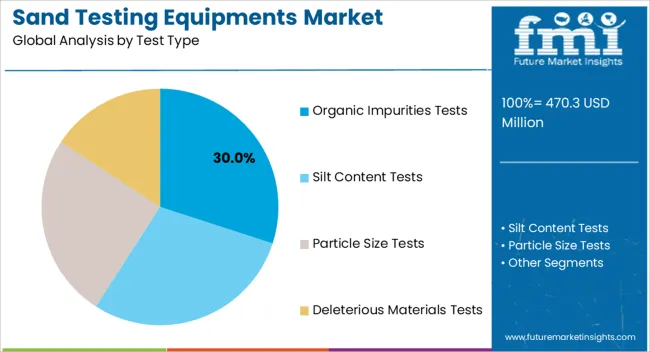
The Organic Impurities Tests segment is projected to hold 30.00% of the Sand Testing Equipments market revenue in 2025, making it a leading segment in the test type category. Growth in this segment is being attributed to the critical role of organic content evaluation in determining sand suitability for construction and industrial processes. Organic impurities can significantly affect the binding properties and durability of concrete and foundry sand.
The increasing focus on material quality and regulatory compliance has driven adoption of tests that accurately measure organic content. Automated testing systems that provide faster and more precise results are being increasingly implemented in laboratories and on-site testing facilities.
As industries aim to minimize construction defects and ensure adherence to standards, the demand for reliable organic impurity testing is being enhanced The ability to integrate these tests with data monitoring systems and quality management frameworks has further strengthened the segment's market position and is expected to sustain growth.
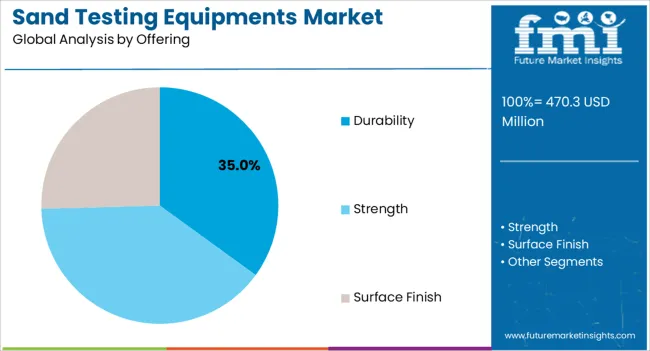
The Durability segment is expected to account for 35.00% of the Sand Testing Equipments market revenue in 2025, representing the leading offering category. Growth in this segment is being driven by the increasing emphasis on long-term structural integrity and the performance of construction materials. Durability tests evaluate resistance to wear, weathering, and chemical exposure, which are crucial for infrastructure and industrial applications.
Adoption has been supported by rising investments in large-scale construction projects where material failure can have significant safety and financial implications. Advanced durability testing equipment allows precise simulation of operational conditions, enabling engineers and manufacturers to make informed decisions on material suitability.
The integration of testing instruments with digital monitoring systems provides detailed insights that improve construction planning and reduce risks With an increasing focus on sustainable construction and high-performance materials, the demand for durability testing solutions is expected to continue its strong growth trajectory.
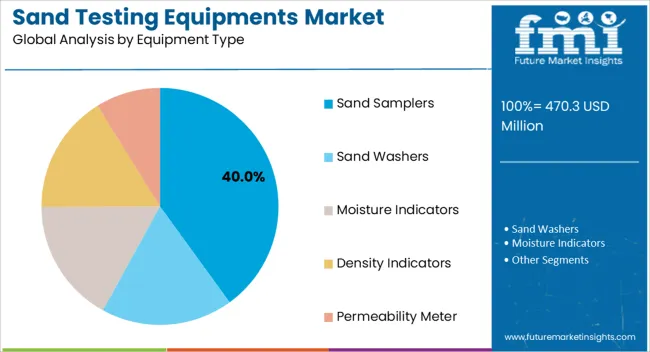
The Sand Samplers segment is anticipated to hold 40.00% of the Sand Testing Equipments market revenue in 2025, making it the leading equipment type. The growth of this segment is being driven by the essential role of accurate sample collection in ensuring reliable testing results. High-quality sand samplers enable consistent and representative sampling, which is critical for laboratory analysis and on-site evaluation.
Industries are increasingly adopting standardized sampling procedures to comply with regulatory requirements and quality assurance protocols. The use of samplers minimizes errors caused by human intervention and ensures repeatability across tests, which enhances the credibility of analytical results.
The segment has further benefited from the development of portable and automated samplers that can improve efficiency in field operations As the importance of quality control and process validation grows across construction and industrial sectors, the demand for sand samplers is expected to remain robust, underpinning the segment's dominant market position.
The sand testing equipments test the various components of sand used in construction of concrete which include natural sand, crushed stone sand, and crushed gravel sand stone dust. The sand should be hard, durable, chemically inert and free from adherent coatings, organic matters etc.
The sand testing equipments provide the information about the organic impurities like iron, mica, alkalis present in the sand, moisture content in the sand, clay. The particles of sand have different sizes. The sand testing equipments are used to test whether the sand particles are within graded zones or not.
As sand is the prime factor used in construction works after water the sand testing equipments are required to be highly efficient, accurate and reliable.
The construction industry is expected to witness significant growth during the forecast periods. The increasing construction works are expected to fuel the growth in sand testing equipments market.
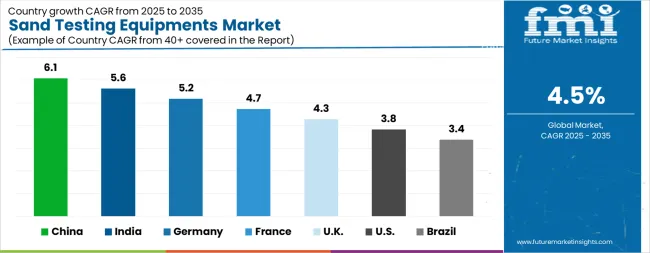
| Country | CAGR |
|---|---|
| China | 6.1% |
| India | 5.6% |
| Germany | 5.2% |
| France | 4.7% |
| UK | 4.3% |
| USA | 3.8% |
| Brazil | 3.4% |
The Sand Testing Equipments Market is expected to register a CAGR of 4.5% during the forecast period, exhibiting varied country level momentum. China leads with the highest CAGR of 6.1%, followed by India at 5.6%. Developed markets such as Germany, France, and the UK continue to expand steadily, while the USA is likely to grow at consistent rates. Brazil posts the lowest CAGR at 3.4%, yet still underscores a broadly positive trajectory for the global Sand Testing Equipments Market. In 2024, Germany held a dominant revenue in the Western Europe market and is expected to grow with a CAGR of 5.2%. The USA Sand Testing Equipments Market is estimated to be valued at USD 162.9 million in 2025 and is anticipated to reach a valuation of USD 237.1 million by 2035. Sales are projected to rise at a CAGR of 3.8% over the forecast period between 2025 and 2035. While Japan and South Korea markets are estimated to be valued at USD 22.1 million and USD 15.5 million respectively in 2025.
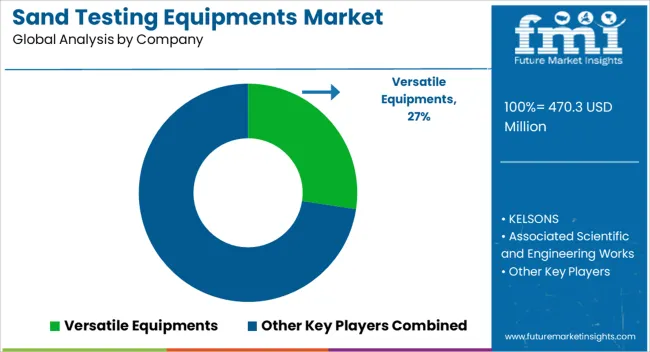
| Item | Value |
|---|---|
| Quantitative Units | USD 470.3 Million |
| Test Type | Organic Impurities Tests, Silt Content Tests, Particle Size Tests, and Deleterious Materials Tests |
| Offering | Durability, Strength, and Surface Finish |
| Equipment Type | Sand Samplers, Sand Washers, Moisture Indicators, Density Indicators, and Permeability Meter |
| Regions Covered | North America, Europe, Asia-Pacific, Latin America, Middle East & Africa |
| Country Covered | United States, Canada, Germany, France, United Kingdom, China, Japan, India, Brazil, South Africa |
| Key Companies Profiled | Versatile Equipments, KELSONS, Associated Scientific and Engineering Works, China Liming Heavy Industry Science and Technology, LG, CB Machinery, Supertech Scientific and Metallurgical Services, Simpson Technologies, Royals Enterprises, Ideal Engineering & Technology, and Usha Instruments & Chemicals |
The global sand testing equipments market is estimated to be valued at USD 470.3 million in 2025.
The market size for the sand testing equipments market is projected to reach USD 730.3 million by 2035.
The sand testing equipments market is expected to grow at a 4.5% CAGR between 2025 and 2035.
The key product types in sand testing equipments market are organic impurities tests, silt content tests, particle size tests and deleterious materials tests.
In terms of offering, durability segment to command 35.0% share in the sand testing equipments market in 2025.






Our Research Products

The "Full Research Suite" delivers actionable market intel, deep dives on markets or technologies, so clients act faster, cut risk, and unlock growth.

The Leaderboard benchmarks and ranks top vendors, classifying them as Established Leaders, Leading Challengers, or Disruptors & Challengers.

Locates where complements amplify value and substitutes erode it, forecasting net impact by horizon

We deliver granular, decision-grade intel: market sizing, 5-year forecasts, pricing, adoption, usage, revenue, and operational KPIs—plus competitor tracking, regulation, and value chains—across 60 countries broadly.

Spot the shifts before they hit your P&L. We track inflection points, adoption curves, pricing moves, and ecosystem plays to show where demand is heading, why it is changing, and what to do next across high-growth markets and disruptive tech

Real-time reads of user behavior. We track shifting priorities, perceptions of today’s and next-gen services, and provider experience, then pace how fast tech moves from trial to adoption, blending buyer, consumer, and channel inputs with social signals (#WhySwitch, #UX).

Partner with our analyst team to build a custom report designed around your business priorities. From analysing market trends to assessing competitors or crafting bespoke datasets, we tailor insights to your needs.
Supplier Intelligence
Discovery & Profiling
Capacity & Footprint
Performance & Risk
Compliance & Governance
Commercial Readiness
Who Supplies Whom
Scorecards & Shortlists
Playbooks & Docs
Category Intelligence
Definition & Scope
Demand & Use Cases
Cost Drivers
Market Structure
Supply Chain Map
Trade & Policy
Operating Norms
Deliverables
Buyer Intelligence
Account Basics
Spend & Scope
Procurement Model
Vendor Requirements
Terms & Policies
Entry Strategy
Pain Points & Triggers
Outputs
Pricing Analysis
Benchmarks
Trends
Should-Cost
Indexation
Landed Cost
Commercial Terms
Deliverables
Brand Analysis
Positioning & Value Prop
Share & Presence
Customer Evidence
Go-to-Market
Digital & Reputation
Compliance & Trust
KPIs & Gaps
Outputs
Full Research Suite comprises of:
Market outlook & trends analysis
Interviews & case studies
Strategic recommendations
Vendor profiles & capabilities analysis
5-year forecasts
8 regions and 60+ country-level data splits
Market segment data splits
12 months of continuous data updates
DELIVERED AS:
PDF EXCEL ONLINE
Sandwich Panel System Market Size and Share Forecast Outlook 2025 to 2035
Sand Abrasion Tester Market Size and Share Forecast Outlook 2025 to 2035
Sandhoff Disease Therapeutics Market Size and Share Forecast Outlook 2025 to 2035
Sandwich Maker Market Size and Share Forecast Outlook 2025 to 2035
Sand Blasting Machines Market Size and Share Forecast Outlook 2025 to 2035
Sand Processing Equipment Market Size and Share Forecast Outlook 2025 to 2035
Sandblasting Media Market Size and Share Forecast Outlook 2025 to 2035
Sand Screens Market Analysis - Size, Growth, and Forecast 2025 to 2035
Sand Control Screens Market Growth - Trends & Forecast 2025 to 2035
Testing, Inspection & Certification Market Growth – Trends & Forecast 2025 to 2035
Sandwich Containers Market Insights & Industry Analysis 2023-2033
Sand Control Tools Market
Sanding Sugar Market
Sander Market
Sandwich Preparation Refrigerators Market
Sandboxing Market
Sandbags Market
5G Testing Market Size and Share Forecast Outlook 2025 to 2035
AB Testing Software Market Size and Share Forecast Outlook 2025 to 2035
5G Testing Equipment Market Analysis - Size, Growth, and Forecast 2025 to 2035

Thank you!
You will receive an email from our Business Development Manager. Please be sure to check your SPAM/JUNK folder too.
Chat With
MaRIA